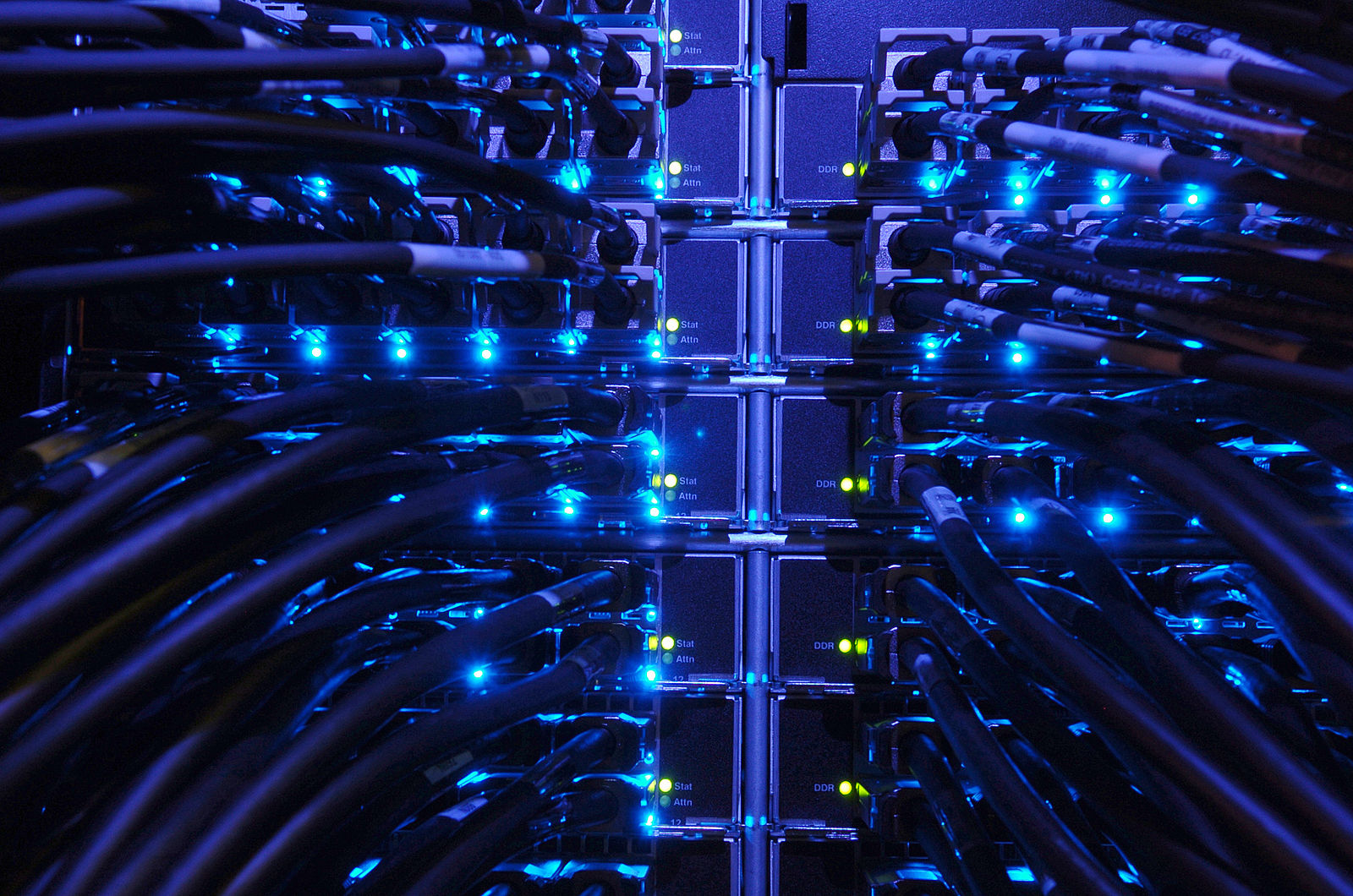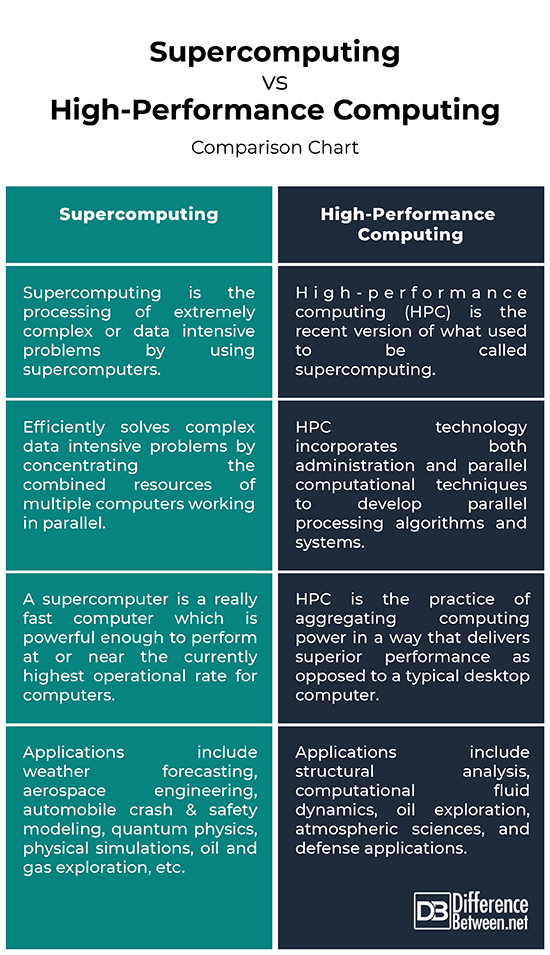Difference Between Supercomputing and High-Performance Computing
For many years, high performance computing has demonstrated the ability of modeling and predicting accurately a wide range of physical properties and phenomena. Many of these have had a profound effect on the world around us, contributing to wealth creation and improving the quality of life. However, the need for real-time solutions for large scale problems have led to the era of faster, more powerful machines, called the supercomputers. A supercomputer is a powerful and expensive system at any given time. These are used in everything from weather forecasting, aerospace engineering, automobile crash and safety modeling, and complex mathematical problems that require large scale computing.
Digital computing has evolved to higher levels into a highly specialized and challenging field. High-performance computing (HPC) is the recent version of what used to be called supercomputing. HPC is a tool used in science and engineering, due to innovative hardware, software and algorithmic advances. Initially, vector processors dominated supercomputing and that changed with parallel computing, which emerged as a major tool for scientific computing. Computing performance has grown dramatically over the years. Today, we are entering a new era of high performance computing and one can only envision greater developments in computing.

What is a Supercomputing?
Supercomputing refers to the processing of insanely complex or data-laden tasks using the combined resources of multiple computers working in parallel (which is a supercomputer). The term supercomputing is associated with supercomputers meaning computers systems which are powerful to handle high performance computing as opposed to general purpose computer. Supercomputers, in fact, are the fastest computers till date and hence the backbone of computational sciences. They are capable enough to process and generate huge amounts of data with unparalleled speed and efficiency. The hardware structure or architecture of supercomputers determines the efficiency of supercomputing systems. Today, supercomputers are used for highly intensive calculation tasks for projects ranging from quantum physics, weather forecasting, physical simulations, and molecular modeling. They can be used for simulations of airplanes in wind tunnels, splitting electrons, detonation of nuclear weapons, oil and gas exploration, and more.

What is a High-Performance Computing?
High-performance computing (HPC) is the use of supercomputers and parallel computing techniques to solve complex computational problems. Parallel computing is when a number of compute elements work in collaboration to solve a problem. All modern supercomputer architectures rely heavily on parallelism. In general, HPC is the practice of aggregating computing power in a way that delivers superior performance as opposed to a typical desktop computer. For years, high performance computing has demonstrated the ability to model and predict a wide range of physical properties and phenomena accurately. HPC architecture is influenced by the lowest-level technologies and circuit design, and how they can be most effectively employed in supercomputers. HPC is one of the applications of supercomputers that would allow them to solve computational problems that are too large for typical desktop computers to handle.
Difference between Supercomputing and High-Performance Computing
Technology
– Supercomputing is the processing of extremely complex or data intensive problems by concentrating the combined resources of multiple computers working in parallel (which is a supercomputer). A supercomputer is a really fast computer which is powerful enough to perform at or near the currently highest operational rate for computers. High-performance computing (HPC) is the recent version of what used to be called supercomputing. HPC is a tool used in science and engineering, due to innovative hardware, software and algorithmic advances. HPC is the use of supercomputers and parallel computing techniques to solve complex computational problems.
Applications
– HPC technology incorporates both administration and parallel computational techniques to develop parallel processing algorithms and systems. By leveraging the parallel nature of the high-performance computing systems, HPC can be used in a wide variety of applications such as structural analysis, computational fluid dynamics, oil exploration, atmospheric sciences, and defense applications. Other applications include virtual reality, computational chemistry, finance, transportation, etc.
Supercomputers are the backbone of computational sciences and used for a wide range of complex tasks that would require computing across various fields, including weather forecasting, aerospace engineering, automobile crash and safety modeling, quantum physics, physical simulations, molecular modeling, oil and gas exploration, and more.
Supercomputing vs. High-Performance Computing: Comparison Chart

Summary
The term supercomputing is associated with supercomputers meaning computers systems which are powerful to handle high performance computing as opposed to general purpose computer. A supercomputer refers to a powerful and expensive system achieved by innovative usage of newer hardware and software concepts. From vector processors to the current strategies of parallel processing, digital computing has evolved into a highly specialized field. High-performance computing (HPC) is the recent version of what used to be called supercomputing. HPC is a great tool in science and engineering which incorporates both administration and parallel computational techniques to develop parallel processing algorithms and systems.
- Difference Between Caucus and Primary - June 18, 2024
- Difference Between PPO and POS - May 30, 2024
- Difference Between RFID and NFC - May 28, 2024
Search DifferenceBetween.net :
Leave a Response
References :
[0]Segall, Richard S. et al. Research and Applications in Global Supercomputing. Hershey, Pennsylvania: IGI Global, 2015. Print
[1]Hager, Georg and Gerhard Wellein. Introduction to High Performance Computing for Scientists and Engineers. Boca Raton, Florida: CRC Press, 2010. Print
[2]Sengupta, Tapan. High Accuracy Computing Methods: Fluid Flows and Wave Phenomena. Cambridge, United Kingdom: Cambridge University Press, 2013. Print
[3]Allan, R.J. et al. High-Performance Computing. Berlin, Germany: Springer, 1999. Print
[4]Dongarra, J.J. et al. High Performance Computing: Technology, Methods and Applications. Amsterdam, Netherlands: Elsevier, 1995. Print
[5]Image credit: https://commons.wikimedia.org/wiki/File:IBM_Blue_Gene_P_supercomputer.jpg
[6]Image credit: https://commons.wikimedia.org/wiki/File:Nanoscience_High-Performance_Computing_Facility.jpg
